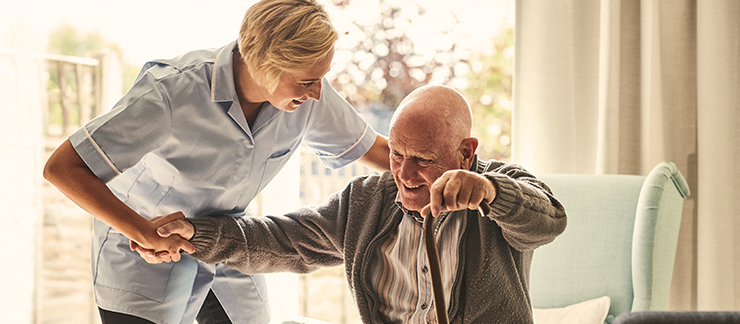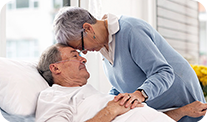
Safe Patient Handling
Physical safety in caregiving is a necessary consideration. Providing elderly care for your family member or loved one can be very challenging on several levels. Mentally, it’s taxing. Financially, it can be a strain. Logistically, it can also be very difficult. But what about the physical strain and toll on the caregiver?
The physical aspects of caring for a loved one in a home environment can be demanding, but often are not given a lot of thought or planning. Yet for nurses, who we as caregivers often take the place of in home care, manual lifting and repositioning of patients accounted for their highest risk for injury. A study from the US Department of Labor found that healthcare workers suffer higher rates of injuries than both the construction and manufacturing industries. If this is still a major issue in the professional healthcare environment—where there are standards, protocols, and equipment to address these challenges, how can we possibly address it at home, where none of that is in place?
A Safe Environment: Helps the Caregiver, Helps the Patient
The good news is there are things we can do to address caregiver safety at home. In the healthcare environment, safe patient handling and mobility (SPHM) standards have been developed to ensure safety for both the healthcare worker and the patient, and to promote a safer work environment and a safer healing environment. Patients who do not receive care that includes correct positioning, lifting, and movement have a higher risk of developing pressure ulcers, skin tears, pneumonia, and organ atrophy. The standards and protocols developed for hospitals and professional staff address these risks. Piggybacking off of some of those standards can help us create a safer home environment for ourselves as caregivers, and will also result in fewer complications for our loved ones at home. While hospitals across the US are now required to follow newly developed standards to ensure a “culture of safety” for the patient and staff, why shouldn’t we aim for the same standards to be in place at home?
What Movements Cause Injury?
In the US, we have an aging population that has increased health conditions such as obesity. Some of these conditions present significant challenges to home care and place both caregivers and patients at higher risk of injury.
Many of the professional nursing injuries that occur are from repeated side lifting movements (manually repositioning/sliding/pulling a patient up in bed). This type of side listing motion creates a shearing force on the spine that can result over time in what are called micro tears, which weaken the spine, damage discs, damage shoulders, and make one more prone to more acute injury. Therefore, we must try to reduce the need for caregivers to perform this type of lifting at home.
A caregiver typically ends up performing tasks that increase risk for caregiver injury: lifting heavy things, heavy turning, pushing/pulling, repeated lifting and moving of equipment, doing transfers on uneven surfaces (from chair to bed, bed to toilet, bed to stretcher, etc.), and awkward positioning. All of these aspects of physical care lead to damage and injury such as micro tears. Additionally, space limitations due to equipment in small spaces can cause tripping and falling hazards. Caregivers need to learn how to avoid these risk factors to ensure both their own personal safety and that of their loved one.
As caregivers we also sometimes must manage loved ones who are fearful, angry or depressed at times, all of which lead to increased risk of injury.
To reduce caregiver injury risk, the caregiver must learn about proper lifting techniques and proper body placement when lifting or transferring a loved one. A caregiver also needs to learn to handle the challenging situations mentioned above, and also assess and remove certain environmental risks in the home.
Safe Lifting: How Do We Do It?
Our spine is where most of our movement is generated, and in being used constantly, it is vulnerable to cumulative injuries from repetitive lifting. The most important aspect of preventing shoulder, neck, and back injuries is learning a proper lifting technique. To reduce injury risk, caregivers should aim for the following ergonomic goals when lifting and transferring patients:
- Face your loved one, and make sure your feet are positioned as close as possible to him and are stable. Keep weight equally distributed between feet and make sure they are pointed toward your loved one before and during lifting to ensure stability.
- Bend knees slightly and squat in preparation to lift. Keep your back straight and brace your core in order to add lifting strength and obtain strength from arms and legs.
- If possible, place one foot in between your loved one’s feet and one foot on the outside for better stability.
- When lifting, try to use a smooth flowing motion, using your legs to push upward.
- Avoid stooping, leaning, bending, and extended bending by staying close to your loved one as you lift or position.
- When possible, avoid awkward body positions and unstable or slippery surfaces when lifting, bathing, dressing or positioning a loved one.
Injury risk can also be decreased with use of equipment such as patient lifts, grab bars, toilet seat risers, and adjustable shower benches and bath chairs.
Injury risk can also be decreased with planning. This includes overall planning and training on proper methods of positioning and lifting. It also includes daily planning of activities ahead of time to reduce the number of transfers and lifting.
Other Hazards and Getting Guidance
Beyond muscle, neck, and back injuries, other risk factors to caregiver injury include exposure to sickness and to contagious conditions from bodily fluids, and exposure to needle sticks from handling injections for diabetes and other conditions.
Caregivers should research local resources and join in community center or healthcare facility sessions that offer training on basic care giving skills for non-professionals. Local hospital nursing departments, physical therapy facilities, and county health departments typically offer community-based resources or can point you in the direction of some. Ask doctors and occupational and physical therapy staff for tips on physically caring for your loved one at home.
Know When to Say When
Knowing when to ask for help in providing care for your loved one will prevent accidents and injuries for you both. If and when you feel the physical demands of care are becoming too challenging, you can ask a professional (such as an occupational therapist) to assess the home environment and needs, look into equipment/devices that help aid in lifting and transferring (such as a patient lift), or perhaps begin researching housing alternatives that provide an increased level of care.
The focus on home care is safety—for both you and your loved one!


